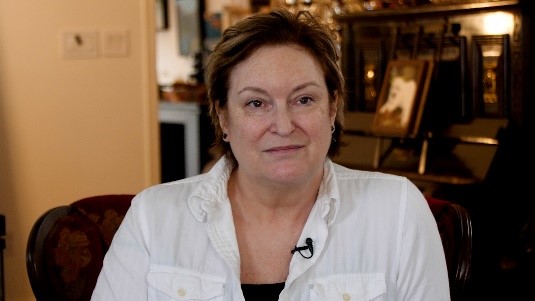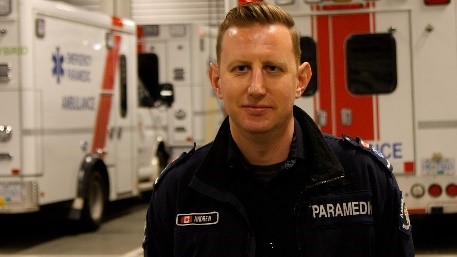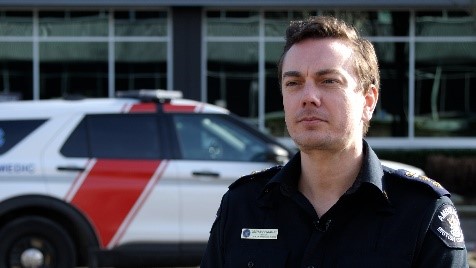Friday, December 3, 2021, is a day Victoria resident Gennifer Ryan recalls now with a mix of heartache and gratitude. She was with her husband Jim, looking after him and doing everything possible to honour his wishes to be at home as much as possible after a diagnosis of palliative lung cancer. But on that day, he needed immediate help and she called 9-1-1 for an ambulance.
Paramedics were dispatched to the home and Gennifer says as soon as they arrived, they took control of the situation and offered expert care to help with Jim’s pain crisis:
 “They were able to get my husband stabilized, get me calm, and get him out of pain,” explains Gennifer. Her voice catches with emotion as she recalls the gratitude and relief she felt that paramedics were able to provide that level of care in their home.
“They were able to get my husband stabilized, get me calm, and get him out of pain,” explains Gennifer. Her voice catches with emotion as she recalls the gratitude and relief she felt that paramedics were able to provide that level of care in their home.
“The fact that their job was to get the patient stabilized and triaged “in situ” made the world of difference to us. We knew he only had weeks left, and this was one of the diamonds in the care that we had received.”
Prior to 2019, when someone in B.C. called 9-1-1 for medical help, paramedics dispatched to a call were generally mandated to take patients to hospital. But hospital emergency departments are not always where a person with an end-of-life condition wants or needs to be.
Thanks to a number of important changes in the past few years, including a
national training program, a new model of care, legislative amendments, and partnerships with regional health authorities, paramedics in B.C. are empowered with more options for their patients. Options include treatment at home, referral to other services, or bringing patients to a more appropriate location for treatment, instead of taking them to hospital emergency departments.
Formalized training for paramedics began in 2019, through a multi-year funding grant provided by the
Canadian Partnership Against Cancer and Healthcare Excellence Canada.
There are now at least 1300 B.C. paramedics who have received the specialized training in palliative care and a new model to allow paramedics to offer enhanced care. This new process is termed “ASTaR,” which stands for Assess, See, Treat and Refer. The ASTaR palliative clinical pathway supports paramedics in delivering enhanced care to palliative patients who call 9-1-1.
BCEHS palliative-care trained paramedics work closely with existing palliative and community care teams in health authorities and share patient event details and interventions provided, to ensure continuity of care.
BCEHS initially introduced the ASTaR approach in five communities - Prince George, Nanaimo, Kamloops, North Vancouver/West Vancouver, and Abbotsford, and has now been expanded province-wide, with additional community teams coming online each month.
 Between 2019 and 2022, more than 400 9-1-1 calls to BCEHS have met the guidelines for the ASTaR pathway, meaning patients were treated by paramedics so that they were able to remain in their homes.
Between 2019 and 2022, more than 400 9-1-1 calls to BCEHS have met the guidelines for the ASTaR pathway, meaning patients were treated by paramedics so that they were able to remain in their homes.
Andrew Mills, an advanced care paramedic, and one of the paramedics who responded to Gennifer and Jim’s home last December, says the new model is proving to be empowering for patients and their families. He recalls that day in December when this new approach was put into action for Gennifer and Jim Ryan.
“As soon as we started to explain to the patient and his wife that our main goal was to resolve and address his pain crisis, and that we had the ability to do that within our clinical ability in their home, she was on board right away, and the patient was as well.”
 BCEHS’ Director of Clinical and Professional Practice, Leon Baranowski, says the new approach may seem counterintuitive at first, with paramedics spending so much more time in the patient’s home, rather than whisking them away to hospital. But when reviewed, it turns out that overall time per call is often significantly reduced, freeing up paramedics sooner to respond to other patients.
BCEHS’ Director of Clinical and Professional Practice, Leon Baranowski, says the new approach may seem counterintuitive at first, with paramedics spending so much more time in the patient’s home, rather than whisking them away to hospital. But when reviewed, it turns out that overall time per call is often significantly reduced, freeing up paramedics sooner to respond to other patients.
“Clinical practice has fundamentally changed in B.C. in the last couple of years,” says Baranowski. We’ve now got clinical leads that are specifically tasked with looking at how we can develop our care, and better models of care for patients across the province.”
For more on this new approach for palliative patients who call 9-1-1, watch these videos:
Patient Story: Palliative Care by BCEHS
Paramedic Practice: BCEHS Palliative Care

